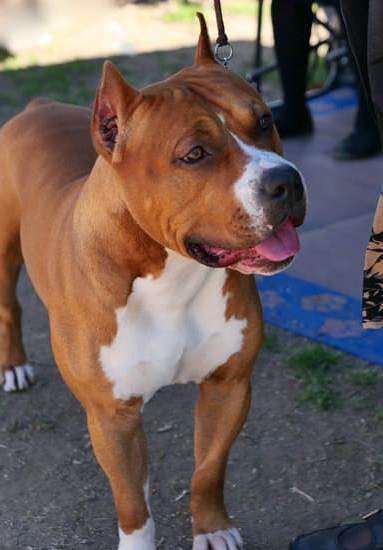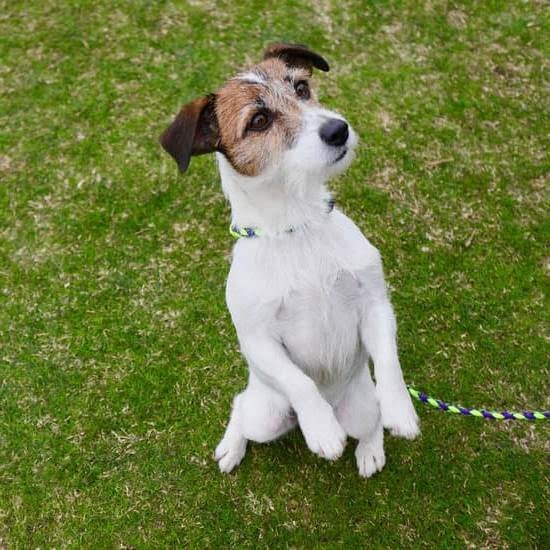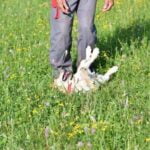Having a dog that jumps up on people can be a frustrating and sometimes even embarrassing behavior. Learning how to train your dog to not jump is essential for creating a well-behaved pet that can interact positively with others. Understanding why dogs jump in the first place is the first step in addressing this issue effectively.
Dogs may jump for various reasons, such as seeking attention, greeting excitement, or asserting dominance. It’s important to recognize the underlying cause of your dog’s jumping behavior to develop a targeted training approach. By exploring these reasons behind why dogs jump, you can tailor your training methods to address the specific triggers that lead to this unwanted behavior.
The negative impact of jumping goes beyond simple nuisance – it can affect interactions with others and cause inconvenience in various situations. Whether your dog’s jumping leads to scratched furniture, knocked-over objects, or uncomfortable greetings with guests, taking proactive steps to curb this behavior is crucial. Consistency in training is key when teaching your dog how to greet people politely and engage in appropriate behaviors without resorting to jumping.
The Negative Impact of Jumping
When a dog jumps, it can have a negative impact on interactions with others and cause inconvenience for both the pet owner and those around them. Understanding the reasons behind this behavior is essential in addressing it effectively. Dogs often jump out of excitement, to seek attention, or due to lack of impulse control. By recognizing these triggers, pet owners can better manage their dog’s jumping behavior.
The habit of jumping can lead to various problems in daily life. For example, a dog that jumps on guests can be intimidating or even dangerous, especially if the guest is a child or someone who is not comfortable around dogs.
Furthermore, jumping can also result in torn clothes, scratches, and other forms of physical discomfort for people who come into contact with the dog. In public spaces, an overexcited dog that jumps on strangers can create chaos and potentially lead to negative consequences.
To address this issue effectively, consistency in training is crucial. Pet owners must establish clear rules and boundaries to discourage jumping behavior.
Basic obedience training plays a significant role in teaching dogs essential commands such as “sit” or “down,” which can help redirect their energy in more appropriate ways. By incorporating positive reinforcement techniques into training sessions, such as rewarding good behavior with treats or praise, pet owners can encourage their dogs to refrain from jumping and instead focus on desired actions.
- Understand why your dog jumps
- Recognize the negative impact of jumping behavior
- Learn about the importance of consistent training methods
Importance of Consistency in Training
Consistency is crucial when it comes to training your dog to not jump. Dogs thrive on routine and clear expectations, so maintaining a steady approach in your training efforts is key to achieving success. In this section, we will explore why consistency plays a vital role in teaching your dog proper behavior and how you can ensure that your training methods are effective.
Building a Strong Foundation
Consistency in training helps build a strong foundation for your dog to understand what is expected of them. By consistently reinforcing desired behaviors and correcting unwanted ones, your dog will learn what is and isn’t acceptable. When working on teaching your dog not to jump, consistency ensures that they understand that jumping is not allowed in any situation.
Establishing Clear Communication
Consistency also helps establish clear communication between you and your dog. When you are consistent in your commands, rewards, and corrections, your dog will have a better understanding of what you are asking of them. This clarity reduces confusion and makes it easier for your dog to learn the desired behavior.
Staying Committed to Training
Training your dog to not jump requires dedication and commitment. Consistency means sticking to the training plan you have outlined for your dog without wavering. It may take time for your dog to fully grasp the concept of not jumping, but with consistent training sessions and reinforcement, you will see progress over time. Remember to be patient and stay committed to the process for the best results in teaching your furry friend how to behave appropriately.
By maintaining consistency in your training efforts, you will set the stage for success in teaching your dog not to jump. Remember that patience, repetition, and positive reinforcement are essential components of consistent training. Stay dedicated to the process, communicate clearly with your pet, and celebrate small victories along the way as you guide them towards better behavior.
Basic Obedience Training
Training your dog to not jump is an essential part of basic obedience training. One of the first steps in teaching your dog better behavior is to establish clear commands that they can follow. Commands such as “sit,” “stay,” and “down” can provide a foundation for addressing jumping behavior. It’s important to practice these commands regularly with your dog in various situations to reinforce their learning and ensure consistency.
Positive reinforcement is a highly effective technique when it comes to training your dog not to jump. Rewarding your dog with treats, praise, or toys when they exhibit good behavior, such as staying on all fours instead of jumping up, can encourage them to repeat this positive behavior. Consistency is key when using positive reinforcement, so be sure to reward your dog every time they refrain from jumping.
In addition to teaching basic commands and using positive reinforcement, redirecting your dog’s energy can also help in preventing jumping behavior. Providing your dog with appropriate outlets for their energy, such as regular exercise and interactive playtime, can reduce their inclination to jump out of excitement. By incorporating physical activities into your daily routine with your furry friend, you can help them release excess energy in a constructive way.
| Training Method | Description |
|---|---|
| Positive Reinforcement | Reward good behavior with treats or praise. |
| Redirecting Energy | Provide exercise and playtime for a healthy outlet. |
Positive Reinforcement Techniques
When it comes to training your dog to not jump, positive reinforcement techniques can be highly effective in encouraging good behavior. One of the key aspects of positive reinforcement is rewarding your dog when they exhibit the desired behavior, such as keeping all four paws on the ground instead of jumping up. This can be done through treats, praise, or favorite toys, depending on what motivates your furry friend.
Consistency is crucial when using positive reinforcement to train your dog. Make sure to reward your dog every time they don’t jump when greeting you or others. By doing this consistently, your dog will learn that not jumping leads to positive outcomes, reinforcing the desired behavior. It’s important to remember that every dog is different, so finding the right reward that motivates your specific pet is essential for successful training.
In addition to rewards, another important aspect of positive reinforcement techniques is timing. Dogs live in the moment and have a short attention span, so it’s important to reward them immediately after they display the desired behavior. This way, they can make a connection between their actions and the reward they receive. With patience, consistency, and the right rewards, you can effectively train your dog to not jump and exhibit polite greetings with both family members and guests.
| Positive Reinforcement Techniques | Reward-Based Methods |
|---|---|
| Consistency | Crucial when using positive reinforcement |
| Timing | Reward immediately after desired behavior |
| Patient | Critical while training your dog |
Redirecting Your Dog’s Energy
When it comes to training your dog to not jump, one important aspect to consider is finding alternative ways for your furry companion to release excess energy. Dogs are energetic animals, and when they don’t have an outlet for their vitality, they may resort to behaviors like jumping. Redirecting your dog’s energy towards more positive activities can help reduce the likelihood of jumping.
One effective method to redirect your dog’s energy is through regular exercise. Ensuring that your dog gets enough physical activity each day can help prevent pent-up energy that may lead to jumping.
Taking your dog on daily walks, engaging in playtime, or incorporating interactive toys can all help burn off excess energy in a healthy way. Additionally, considering activities like agility training or enrolling your dog in obedience classes can provide mental stimulation while also keeping them physically active.
Another way to redirect your dog’s energy is by providing mental enrichment. Engaging your dog’s mind with puzzle toys, scent games, or basic obedience training can help channel their energy into productive outlets.
Mental stimulation is just as important as physical exercise in maintaining a balanced and well-behaved pet. By offering a variety of activities that cater to both their physical and mental needs, you can help curb jumping behavior and promote overall well-being in your furry friend.
Setting Boundaries and Rules
Establishing No Jumping Zone
Create specific areas in your home where jumping is not allowed, such as near the entrance door or around certain pieces of furniture. Use verbal cues like “off” or “down” to signal to your dog that they are not allowed to jump in these designated zones.
Teaching Alternative Behaviors
Instead of jumping, train your dog to perform alternative behaviors such as sitting or lying down when greeting people. Use positive reinforcement techniques, such as treats or praise, to reward your dog for displaying the desired behavior. Consistently reinforcing these alternative behaviors will help replace the habit of jumping with more appropriate actions.
Consistent Training and Correction
Be consistent in correcting your dog whenever they attempt to jump. Use a firm but gentle voice command like “down” or “no” along with a hand signal to discourage jumping. Consistent training sessions will help reinforce the message that jumping is not acceptable behavior. Remember to praise and reward your dog when they respond correctly to your commands.
By setting clear boundaries and rules, you can effectively prevent jumping behavior in your dog. Remember that training takes time and patience, so be consistent in enforcing the rules you have established. With dedication and positive reinforcement, you can train your dog to greet guests politely without resorting to jumping.
Handling Jumping in Different Situations
Dealing with a jumping dog can be challenging, especially in various scenarios such as at home, during walks, and when guests visit. It is essential to address this behavior to ensure the safety of both your dog and others. Here are some tips on how to train your dog to not jump in different situations:
- At Home: One way to discourage jumping at home is by teaching your dog the “off” command. Whenever your dog jumps, calmly but firmly say “off” while gently guiding them back down. Be consistent with this command and reward your dog with treats or praise when they listen. Another helpful technique is to ignore your dog when they jump up and only give attention when all four paws are on the ground.
- On Walks: When out for a walk and your dog starts jumping on you or others, stop walking immediately. Use a short leash to control their movements and command them to sit before continuing the walk. Practice this consistently during walks to reinforce good behavior. Also, distract your dog by giving them a toy or treat whenever they start jumping during a walk.
- When Guests Visit: It can be embarrassing and frustrating when your dog jumps on guests as they arrive. To prevent this behavior, ask guests to avoid eye contact or physical interaction with your dog until they have calmed down. Keep your dog on a leash initially to have better control over their actions. Encourage guests to only give attention when your dog is calm and not displaying any signs of jumping.
By implementing these strategies consistently across different situations, you can effectively train your dog to not jump. Remember that patience and positive reinforcement are key components in modifying this behavior successfully. With time and effort, you will see progress in your dog’s ability to greet others politely without jumping up incessantly.
Seeking Professional Help
When it comes to training your dog to not jump, sometimes seeking professional help can be the key to unlocking more advanced techniques. While basic obedience training and positive reinforcement methods are effective in many cases, there may be instances where a professional trainer can provide specialized guidance tailored to your dog’s specific needs.
A professional trainer can assess your dog’s behavior and temperament to create a personalized training plan that addresses the root cause of their jumping. They have the experience and knowledge to implement more advanced techniques that go beyond what you may be able to achieve on your own. With their expertise, they can offer insights on how to train your dog to not jump in various situations, whether it’s at home, on walks, or when guests visit.
Additionally, a trainer can provide valuable support and guidance for you as well. They can help you understand the nuances of canine behavior and communication, equipping you with the tools needed to effectively communicate with your furry friend. By working closely with a professional trainer, you can build a strong foundation for a harmonious relationship with your dog based on mutual respect and understanding.
Celebrating Progress
In conclusion, training your dog to not jump is a process that requires patience, consistency, and dedication. Understanding the reasons behind why dogs jump is essential in addressing this behavior effectively. By recognizing the negative impact jumping can have on interactions with others and establishing clear boundaries, pet owners can start implementing strategies to train their dogs.
Consistency is key in training your dog to not jump. It’s important to set clear rules and boundaries, and to stick to them throughout the training process. Basic obedience training plays a crucial role in teaching your dog essential commands that can redirect their behavior positively. Positive reinforcement techniques are also highly effective in encouraging good behavior and discouraging jumping.
Moreover, celebrating progress is an important aspect of your dog’s training journey. By acknowledging small victories and milestones along the way, you can stay motivated and continue working towards the ultimate goal of having a well-behaved dog.
Remember, seeking professional help when needed can also provide valuable guidance and support in addressing more complex behaviors. With the right approach and commitment, you can successfully train your dog to not jump and enjoy a harmonious relationship with your furry companion.
Frequently Asked Questions
How Do You Train a Dog to Stop Jumping on You?
Training a dog to stop jumping on you requires consistency, patience, and positive reinforcement. One effective method is to ignore your dog when they jump up and only give them attention when all four paws are on the ground. You can also train them to sit or offer an alternative behavior like shaking hands.
Will My Dog Grow Out of Jumping Up?
Whether or not your dog will grow out of jumping up largely depends on their training and socialization. Consistent training from a young age can help prevent jumping behaviors from becoming ingrained habits. However, if the behavior has already been established, it may require time and effort to correct.
What Is the Dog Command for No Jumping?
The dog command for discouraging jumping is “Off” or “Down.” It’s important to use a firm but calm tone when giving this command to convey that jumping is not acceptable behavior. Consistency in using the command and rewarding desired behaviors will help reinforce the message to your dog.

Welcome to the blog! I am a professional dog trainer and have been working with dogs for many years. In this blog, I will be discussing various topics related to dog training, including tips, tricks, and advice. I hope you find this information helpful and informative. Thanks for reading!





